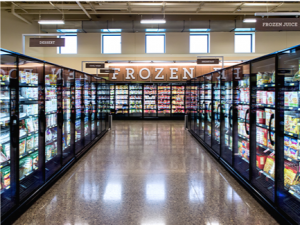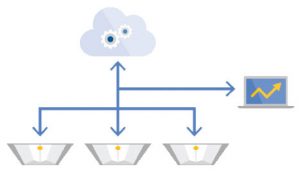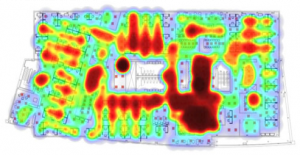The first time I walked down the ice cream aisle at Target and the lights magically turned on as I progressed towards the Ben and Jerry’s section, I was amazed. Looking back, it was one of the first examples of LED lighting sensors being utilized in an everyday application that had a direct impact on the consumer experience.

Today, energy saving sensors of this type are commonplace in both industrial and retail applications. Think high bay fixtures flicking on as a forklift drives down an inventory aisle, or the bathroom lights in your local Starbucks turning on as soon as you open the door.
And while the next wave of control technology does not necessarily have the visually obvious impact that basic motion sensors had, it is having a profound impact on how companies manage their businesses and interact with humans in a given space. Below are a few examples.
Connected Lighting and the Mesh Network
The first thing advanced lighting controls are offering all types of businesses is a wireless connected network of fixtures throughout a given space. These advanced sensors embedded in the individual light fixtures essentially form a mesh network that are able to communicate information and data throughout large footprints to any number of locations.
As an example, a connected lighting system in an industrial application could connect and transport information from specific pieces of equipment, say a compressed air system or motor, and directly communicate that information to a maintenance manager via a text message. Motor A is running 75% hotter than usual and will soon fail, or compressor B is operating 35% longer this week than usual.
In conjunction with this immediate feedback, unique trends can also be identified through data analysis in a central corporate location. For a retail grocery store chain, it could be identified that sites 2, 3 and 4 coolers are consuming 50% more energy than sites 5 , 6 and 7, prompting corporate to contact the site’s personnel to find out why.
This connected network can be extremely powerful for businesses but can communicate information from more than just other pieces of equipment.
Digital Facility Maps and Asset Tracking
Advanced lighting controls can not only communicate to other hardware and equipment but can also actually track assets or people in a given space.
By creating a digital map of a facility, this tracking ability can have a significant impact in all sorts of applications. For a retail grocery store chain, it could be identified that area A sees 90% of all foot traffic that enters the store, as opposed to area B that only sees 35% of foot traffic. Or once an individual arrives in section A of the store, a text message for a coupon of a specific product is sent directly to their phone.
In a manufacturing facility, the lighting system could literally track products as they advance through the assembly process, providing management with real time updates on their progress. Expensive machinery or tools can also be tracked. Employees, vendors or visitors could be tracked to ensure they are in compliance with the site’s rules and regulations.
The insights from this data are only limited by imagination and can literally be designed for each specific facility, its uses and users.
Conclusions
As this technology continues to advance, there is no doubt the Internet or Things (IoT) revolution is upon us. And although the conclusion of its full impact is yet to be determined, the process of watching it unfold across all industries is going to be an exciting one.
If your company is interested in taking advantage of advanced lighting controls and IoT solutions, please contact us to learn more!



